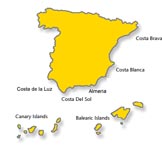Fuerteventura's stone castles are fit for kings
 Jandia, Spain - Some people smile when they see them, others find them annoyingly bourgeois and simply shake their head. Whatever reactions they provoke, the round rock shelters on the southern beaches of Fuerteventura, one of Spain's Canary Islands , are an integral part of many people's holidays and a second lodging for more than a few tourists. Roofless, about 2.5 metres in diameter, and fashioned from local volcanic rock, the shelters offer protection from the wind in addition to privacy for those inside them, most of whom prefer to sunbathe in the nude.
Jandia, Spain - Some people smile when they see them, others find them annoyingly bourgeois and simply shake their head. Whatever reactions they provoke, the round rock shelters on the southern beaches of Fuerteventura, one of Spain's Canary Islands , are an integral part of many people's holidays and a second lodging for more than a few tourists. Roofless, about 2.5 metres in diameter, and fashioned from local volcanic rock, the shelters offer protection from the wind in addition to privacy for those inside them, most of whom prefer to sunbathe in the nude.
The locals call them "hoyos," which means "pits" or "holes." For foreigners, they are "stone castles" or "fortresses " - a term that Javier Aguilera, chief administrator of a club hotel near Jandia resort, diplomatically judged to be "a bit of an exaggeration."
Most of the small enclosures line the beach near the hotel. Loved or not, they are tolerated and have long been a kind of landmark on the island off the coast of Africa.
Rainer, a chef from the town of Sankt Augustin, near the former German capital, Bonn, swears by the shelters. A regular visitor to Fuerteventura, he spends the nights in an apartment and daytime on the beach in his "castle."
Since he retired, Rainer has made his rocky dwelling a little cosier with a sunshade and a sun lounger.
"We are a close-knit group," he said. "Everybody here knows everybody else." After their holidays, group members stay in contact via internet forums, where they post their experiences and opinions.
It does not matter where the tourist hails from - the rules are the same for everyone. One unwritten rule says that an occupied shelter is off-limits to other tourists.
To underscore their occupancy, some people cordon off the shelter's entrance when they step out, attaching a sign with the planned date of their departure from the island: "Reserved until..."
There is hardly ever trouble. Neither the local administration nor the police see reason to intervene. "It's simply tolerated," Aguilera remarked.
Several years ago, however, excavators rolled up one day and levelled a number of shelters.
"It wasn't done to spite the people, but because the beach had become narrower and we needed the space," explained a spokesman for the municipality of Pajara.
While critics question hygienic conditions in the shelters, Rainer, a naturist, insisted, "They are absolutely clean! That's in our own interests."
For some tourists, not only the shelters and their occupants are bothersome.
"A number of guests just complained that a lot of naked people are walking along the beach outside the nudist zones," said hotel director Uwe Prein. "But we can say only that the beach is public and open to everyone. And the Spaniards are tolerant."
Internet: www. spain. info, www. fuerteventuraturismo. com (dpa)